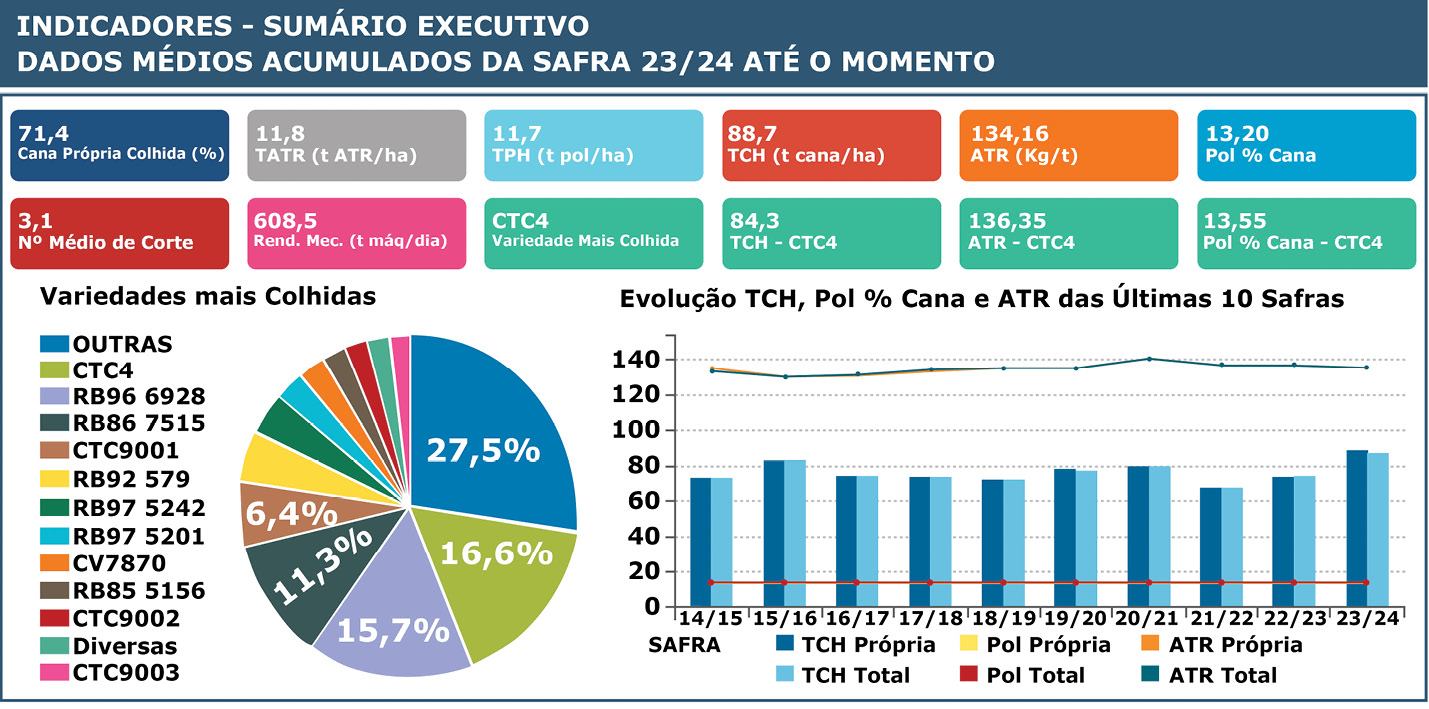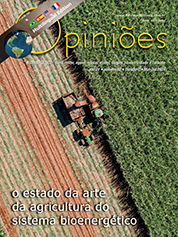Fábio Vidal Mina Jr.
Diretor de Agronegócios e Logística da Consulcana
OpAA80
Iniciativas em relação a novas variedades
A cana-de-açúcar é uma cultura semi-perene, de clima quente e úmido e que possui manejos específicos para atingir o seu pleno desenvolvimento e, consequentemente, o retorno esperado. Dessa forma, entende-se que práticas fora dos padrões adequados fatalmente irão refletir em sua performance, principalmente produtividade e maturação.
Com exceção da última safra (2023/24), tem-se convivido com uma acentuada queda nas produtividades das usinas. Excluindo-se uma minoria, as demais apresentaram uma redução de TCH (toneladas de colmos por hectare) nas safras anteriores. Tal queda pode ter sido ocasionada por diversos motivos, a saber:
1) expansão da área de cana em áreas até então não cultivadas com cana-de-açúcar (pastagens, eucaliptos, citros) em áreas menos férteis etc;
2) problemas com nutrição e manejo (agravado com as últimas crises interna e externa);
3) diminuição das áreas de reforma e consequente aumento do número médio de corte (historicamente a taxa média de renovação do canavial era de 17%; houve uma queda para 13,5% e, atualmente, 15,8%);
4) idade média de corte;
5) plantio de cana de inverno, cana de ano e/ou plantio o ano inteiro;
6) crescente expansão de áreas com colheita mecanizada.
Enfim, mudanças importantes que ocorreram no manejo tradicional até então aplicado e que, certamente, impactaram/contribuíram para a redução da produtividade das últimas safras. É evidente que, devido aos diferentes “anos agrícolas” que atravessaram esses canaviais, houve também influências de clima, temperatura, chuvas etc.
Obviamente, existem muitas variáveis que influenciam nas alterações constantes de produtividade das safras, de modo que, indubitavelmente, o elenco varietal é fundamental. Se não fossem esse dinamismo no desenvolvimento e liberação de novos materiais promissores e/ou variedades com características superiores às já existentes, o cenário seguramente estaria ainda pior e muito mais preocupante.
Na imagem em destaque é possível notar claramente as sucessivas quedas de produtividade, assim como as variações de uma safra para outra, exceção à safra 2023/24, em que vários fatores convergiram e contribuíram para uma das mais espetaculares safras dos últimos tempos em produtividade.
Desafio: Sabemos que já existem tecnologias disponíveis no mercado, inclusive com usinas utilizando a matriz tridimensional, conhecida também como “terceiro eixo”, modelos de irrigação permanente, foco na melhoria de alguns importantes pilares que buscam a produtividade de três dígitos, entre outros.
Com exceção de algumas usinas que possuem a condição de ter sua área totalmente irrigada, foi possível perceber que as boas produtividades agrícolas de outras unidades estão mais ligadas aos pilares e manejo de novas variedades do que a mudanças radicais ou disruptivas no sistema de produção da cana.
Identificamos em comum, em algumas usinas, que elas trabalham bem os oito pilares da alta produtividade agrícola:
1) estande varietal sem falhas;
2) redução de perdas na colheita;
3) estratégias adequadas de plantio;
4) caminhamento coerente de safra;
5) nutrição arrojada da cana;
6) fatores redutores de produtividade agrícola sob controle (pragas, ervas daninhas e doenças);
7) ciclo produtivo ótimo;
8) irrigação econômica.
5) nutrição arrojada da cana;
6) fatores redutores de produtividade agrícola sob controle (pragas, ervas daninhas e doenças);
7) ciclo produtivo ótimo;
8) irrigação econômica.
Novas variedades: Sabe-se que a cana-de-açúcar é uma cultura altamente responsiva à água, fazendo com que esse insumo por si só já traga um enorme resultado positivo na busca pela produtividade, aliado ao clima quente e a horas de luz adequada. Esses elementos (água, temperatura e luz) talvez expliquem ou justifiquem por que o Brasil é o maior produtor de cana-de-açúcar do mundo.
Estudo realizado pelo fisiologista Paul H. Moore (2009), Hawaii Agricultural Research Center (Centro de Pesquisa Agrícola do Havaí), aponta potencial teórico máximo da cana-de-açúcar em 472 t/ha. Logo, não é possível falar nas principais iniciativas em relação a novas variedades de cana sem ressaltarmos a base fundamental onde se inicia todo o processo de novos materiais, ou seja, as variedades de cana são de crucial importância no processo da busca por altas produtividades e maturação, sendo, pois, os órgãos de pesquisa e desenvolvimento de variedades (como IAC, CTC, Ridesa) os principais provedores e de maior relevância no processo de desenvolvimento e liberação de novas variedades de cana, juntamente com a colaboração de algumas universidades, onde há uma labuta permanente em busca de novos clones superiores e futuras variedades que satisfaçam a insaciável necessidade do setor.
Nota-se, nos últimos anos, uma troca significativa no plantel de variedades, onde materiais que ocupavam e/ou eram cultivados comercialmente em grandes áreas foram cedendo espaço para novos materiais promissores e com alto potencial de produtividade, riqueza, sanidade, ecléticos quanto ao ambiente de produção (solo), “colheitabilidade” e longevidade. Não obstante isso seja o objetivo desejado, tivemos através dos excelentes trabalhos dos órgãos de pesquisa e liberação varietal uma grande contribuição ao setor sucroenergético com ótimas opções de variedades: IACs, CTCs, CVs, RBs. Todavia, salientamos que não basta termos excelentes variedades disponíveis no mercado e não sabermos tirar o máximo de retorno delas. É importante ressaltar que a alocação correta das variedades não traz nenhum custo adicional, pois o custo fazendo da forma certa ou errada será o mesmo.
Sendo assim, se fizermos a escolha da variedade de forma assertiva, equalizando épocas de plantio, colheita (materiais para início, meio e fim de safra) e ambiente de produção adequado, sem dúvida alguma já daríamos um grande salto na performance e retorno econômico, onde consequentemente, não haverá necessidade de esperar 5 ou 6 cortes para tentar corrigir um erro eventualmente cometido na formação do canavial.
Com base na importância das variedades de cana na cadeia produtiva de uma usina, há no setor várias alternativas de atualização, abastecimento de informações e trocas de experiências em relação aos manejos varietais utilizados, tais como benchmarkings específicos de variedades por empresas especializadas do setor, em que essa troca de experiência e informações geram conhecimentos a serem aplicados, eventuais ajustes e/ou correções.
As ferramentas citadas anteriormente, sendo bem utilizadas, exploradas e implementadas corretamente, certamente oferecem um ótimo norte em relação ao manejo ideal a ser aplicado às variedades cultivadas comercialmente, ou seja, o compartilhamento dessas experiências e aprendizado tem agregado muito ao setor.
A meu ver, estamos no caminho certo e em um momento de altas expectativas no que diz respeito aos próximos anos, contando com um elenco diversificado de excelentes variedades e clones promissores que atenderão às usinas e aos produtores de cana nos mais diversos ambientes de produção, inclusive no “Ambiente E”, o qual, até há pouco tempo, era um dos gargalos a serem resolvidos e/ou melhorados com novas opções de materiais que atendessem a esse nicho, e agora, felizmente, já existem variedades surgindo para ocupar essa lacuna.





